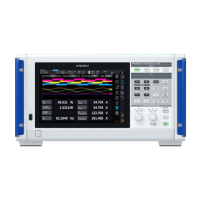198
Functional Specications
(4) Eciency-loss calculations
Function
The eciency
η
(%) and loss (W) of each channel are calculated between wiring
congurations’ active power values.
Calculation item Active power value (P), fundamental wave active power (Pfnd), and motor power (Pm) of each
channel and wiring conguration
Calculation
precision
Performs 32-bit oating-point arithmetic operation for measured values of the parameters
substituted into equations.
When performing calculations between wiring congurations with dierent power range
settings, the largest range in the same calculation is used.
Calculation
interval
Calculations are refreshed at the data refresh intervals.
When performing calculations between wiring congurations with dierent synchronization
sources, the most recent data at the time of the calculation is used.
Number of
calculations that
can be performed
Four for each eciency and loss
Equation Calculation items can be substituted for Pin(n) and Pout(n)
Pin = Pin1 + Pin2 + Pin3 + Pin4 + Pin5 + Pin6
Pout = Pout1 + Pout2 + Pout3 + Pout4 + Pout5 + Pout6
η
= 100
×
|Pout|
|Pin|
, Loss = |Pin| − |Pout|
(5) Delta conversion
Function
Δ
-Y: In 3P3W3M or 3V3A wiring mode, the line voltage waveforms are converted
into phase voltage waveforms using a virtual neutral point.
Y-
Δ
: In 3P4W wiring mode, the phase voltage waveforms are converted into line
voltage waveforms.
All voltage parameters with harmonics components, including voltage RMS
values, are calculated using the converted voltages.
However, the peak-over judgment uses not-converted values.
Equation
Δ
-Y 3P3W3M: U(i)s = (u(i)s − u(i+2)s) / 3, U(i+1)s = (u(i+1)s − u(i)s) / 3,
U(i+2)s = (u(i+2)s − u(i+1)s) / 3
Δ
-Y 3V3A: U(i)s = (u(i)s − u(i+2)s) / 3, U(i+1)s = (u(i+2)s + u(i+1)s) / 3,
U(i+2)s = (−u(i+1)s − u(i)s) / 3
Y-
Δ
: u(i)s = U(i)s − U(i+1)s, u(i+1)s = U(i+1)s − U(i+2)s,
u(i+2)s = U(i+2)s − U(i)s
(i): channel under measurement, u(x)s: sampled line-voltage value, U(x)s: sampled phase-
voltage value
(6) Power calculation method selection
Function Equations for reactive power, power factor, and power phase angle can be selected.
See “10.5 Specications of Equations” (p. 212).
Equation Type 1, Type 2, Type 3
Type 1: Compatible with the Type 1 for each of the PW3390, 3193, and 3390.
Type 2: Compatible with the Type 2 for each of the 3192 and 3193.
Type 3: The active power’s sign can be used as the power factor’ sign.
(Type 1, Type 2, and Type 3 are compatible with each equation of the PW6001.)

